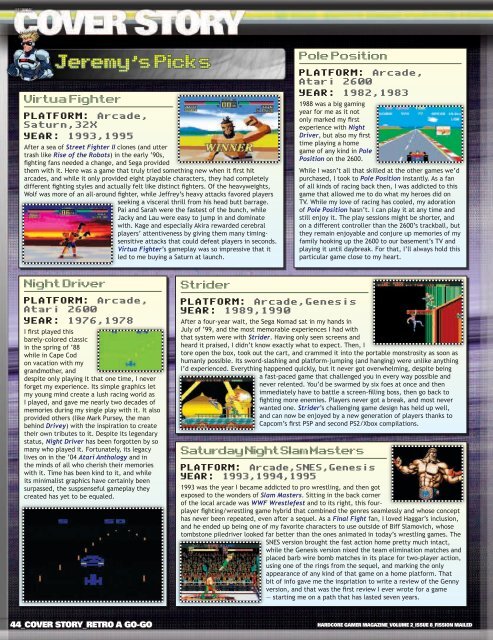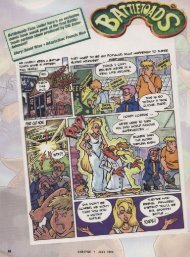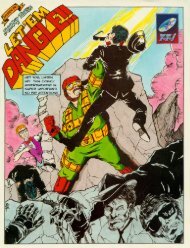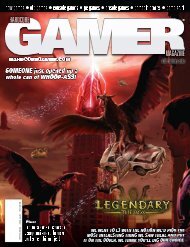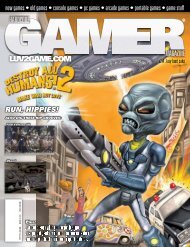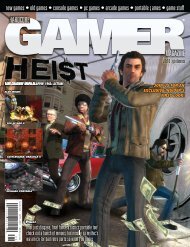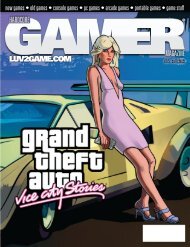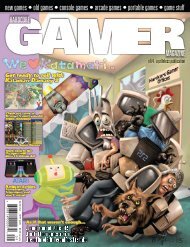Download - Defunct Games
Download - Defunct Games
Download - Defunct Games
Create successful ePaper yourself
Turn your PDF publications into a flip-book with our unique Google optimized e-Paper software.
Jeremy , s Picks<br />
Virtua Fighter<br />
PLATFORM: Arcade,<br />
Saturn,32X<br />
YEAR: 1993,1995<br />
After a sea of Street Fighter II clones (and utter<br />
trash like Rise of the Robots) in the early ‘90s,<br />
fighting fans needed a change, and Sega provided<br />
them with it. Here was a game that truly tried something new when it first hit<br />
arcades, and while it only provided eight playable characters, they had completely<br />
different fighting styles and actually felt like distinct fighters. Of the heavyweights,<br />
Wolf was more of an all-around fighter, while Jeffrey’s heavy attacks favored players<br />
seeking a visceral thrill from his head butt barrage.<br />
Pai and Sarah were the fastest of the bunch, while<br />
Jacky and Lau were easy to jump in and dominate<br />
with. Kage and especially Akira rewarded cerebral<br />
players’ attentiveness by giving them many timingsensitive<br />
attacks that could defeat players in seconds.<br />
Virtua Fighter’s gameplay was so impressive that it<br />
led to me buying a Saturn at launch.<br />
Night Driver<br />
PLATFORM: Arcade,<br />
Atari 2600<br />
YEAR: 1976,1978<br />
I first played this<br />
barely-colored classic<br />
in the spring of ‘88<br />
while in Cape Cod<br />
on vacation with my<br />
grandmother, and<br />
despite only playing it that one time, I never<br />
forget my experience. Its simple graphics let<br />
my young mind create a lush racing world as<br />
I played, and gave me nearly two decades of<br />
memories during my single play with it. It also<br />
provided others (like Mark Pursey, the man<br />
behind Drivey) with the inspiration to create<br />
their own tributes to it. Despite its legendary<br />
status, Night Driver has been forgotten by so<br />
many who played it. Fortunately, its legacy<br />
lives on in the ‘04 Atari Anthology and in<br />
the minds of all who cherish their memories<br />
with it. Time has been kind to it, and while<br />
its minimalist graphics have certainly been<br />
surpassed, the suspsenseful gameplay they<br />
created has yet to be equaled.<br />
Strider<br />
PLATFORM: Arcade,Genesis<br />
YEAR: 1989,1990<br />
Pole Position<br />
PLATFORM: Arcade,<br />
Atari 2600<br />
YEAR: 1982,1983<br />
1988 was a big gaming<br />
year for me as it not<br />
only marked my first<br />
experience with Night<br />
Driver, but also my first<br />
time playing a home<br />
game of any kind in Pole<br />
Position on the 2600.<br />
After a four-year wait, the Sega Nomad sat in my hands in<br />
July of ‘99, and the most memorable experiences I had with<br />
that system were with Strider. Having only seen screens and<br />
heard it praised, I didn’t know exactly what to expect. Then, I<br />
tore open the box, took out the cart, and crammed it into the portable monstrosity as soon as<br />
humanly possible. Its sword-slashing and platform-jumping (and hanging) were unlike anything<br />
I’d experienced. Everything happened quickly, but it never got overwhelming, despite being<br />
a fast-paced game that challenged you in every way possible and<br />
never relented. You’d be swarmed by six foes at once and then<br />
immediately have to battle a screen-filling boss, then go back to<br />
fighting more enemies. Players never got a break, and most never<br />
wanted one. Strider’s challenging game design has held up well,<br />
and can now be enjoyed by a new generation of players thanks to<br />
Capcom’s first PSP and second PS2/Xbox compilations.<br />
Saturday Night Slam Masters<br />
PLATFORM: Arcade,SNES,Genesis<br />
YEAR: 1993,1994,1995<br />
While I wasn’t all that skilled at the other games we’d<br />
purchased, I took to Pole Position instantly. As a fan<br />
of all kinds of racing back then, I was addicted to this<br />
game that allowed me to do what my heroes did on<br />
TV. While my love of racing has cooled, my adoration<br />
of Pole Position hasn’t. I can play it at any time and<br />
still enjoy it. The play sessions might be shorter, and<br />
on a different controller than the 2600’s trackball, but<br />
they remain enjoyable and conjure up memories of my<br />
family hooking up the 2600 to our basement’s TV and<br />
playing it until daybreak. For that, I’ll always hold this<br />
particular game close to my heart.<br />
1993 was the year I became addicted to pro wrestling, and then got<br />
exposed to the wonders of Slam Masters. Sitting in the back corner<br />
of the local arcade was WWF Wrestlefest and to its right, this fourplayer<br />
fighting/wrestling game hybrid that combined the genres seamlessly and whose concept<br />
has never been repeated, even after a sequel. As a Final Fight fan, I loved Haggar’s inclusion,<br />
and he ended up being one of my favorite characters to use outside of Biff Slamovich, whose<br />
tombstone piledriver looked far better than the ones animated in today’s wrestling games. The<br />
SNES version brought the fast action home pretty much intact,<br />
while the Genesis version nixed the team elimination matches and<br />
placed barb wire bomb matches in its place for two-player action,<br />
using one of the rings from the sequel, and marking the only<br />
appearance of any kind of that game on a home platform. That<br />
bit of info gave me the inspriation to write a review of the Genny<br />
version, and that was the first review I ever wrote for a game<br />
— starting me on a path that has lasted seven years.<br />
Pool of Radiance<br />
PLATFORM: Commodore 64<br />
YEAR: 1988<br />
If there was ever a game<br />
that struggled against the<br />
technological constraints<br />
of its day, it was Pool of<br />
Radiance. The Commodore<br />
64 version shipped on eight<br />
double-sided disks, which<br />
required constant swapping and multiple minutes of<br />
loading time. Assuming your disk drive didn’t overheat<br />
in the process, it was worth it: creating a customizable<br />
party of six, you travelled the land of Phlan, righting<br />
wrongs for profitable rewards with nary a rail in<br />
sight. The journal system (which put a majority of<br />
the game’s story-related text into a physical manual)<br />
allowed for a more in-depth plot than RPGs had seen<br />
in a while, when every character of text took up<br />
valuable disk space. Though it<br />
inspired a series of imitators<br />
and sequels (including the<br />
travesty Ruins of Myth<br />
Drannor), none of them ever<br />
matched the original.<br />
Legacy of the Ancients<br />
PLATFORM: Commodore 64<br />
YEAR: 1987<br />
The Commodore 64 had no lack of RPGs. I know this,<br />
because we had most of them. Legacy of the Ancients<br />
sticks out in my mind, though, thanks to its intriguing<br />
framing device. As a native of the planet Tarmalon,<br />
you are charged with a quest to nullify the evil Wizards<br />
Compendium using the exhibits found within the mysterious<br />
Galactic Museum as your guide. You’ll travel the land to<br />
collect special coins that allow you to unlock the displays,<br />
which in turn provide you with special bonuses, or transport<br />
you to dungeons containing treasure and other important<br />
items. Third-person overworld travel was combined with firstperson<br />
dungeon crawling and arcade-style training games to<br />
create a highly varied experience. Sadly, its superior sequel,<br />
The Legend of Blacksilver, was never given a PC re-release.<br />
Indiana Jones and The<br />
Fate of Atlantis<br />
PLATFORM: PC<br />
YEAR: 1994<br />
In any discussion of LucasArts adventure games, the usual<br />
suspects will always come up as nominations for the greatest<br />
of all time: Monkey Island, Day of the Tentacle, Sam & Max, Grim Fandango, or even<br />
Maniac Mansion for the more retro (and masochistic) gamer. While these are all classics, to be<br />
sure, my perennial nomination is Indiana Jones and The<br />
Fate of Atlantis. Based on an original story and full of<br />
globe-spanning intrigue and snappy, sarcastic dialogue,<br />
Fate of Atlantis managed to perfectly capture the feel<br />
of the classic Indy flicks with a Lucasarts twist. Add to<br />
that some breathtaking pixel artistry and a pathsplit<br />
which allowed you to replay the game’s significant<br />
middle portion three times using vastly different<br />
strategies, and you’ve got a recipe for pure enjoyment.<br />
44_COVER STORY_RETRO A GO-GO HARDCORE GAMER MAGAZINE_VOLUME 2_ISSUE 8_FISSION MAILED<br />
HARDCORE GAMER MAGAZINE_VOLUME 2_ISSUE 8_FISSION MAILED<br />
KouAidou , s Picks<br />
Star Control II<br />
PLATFORM: PC<br />
YEAR: 1992<br />
It would be a crime to do a classic games<br />
retrospective and not include Star Control II, so<br />
it’s a good thing it happens to be one of my favorite<br />
games of all time. In control of a powerful alien ship,<br />
you travel the galaxy trying to liberate the human<br />
race (and numerous others) from the control of the paranoid but powerful Ur-Quan,<br />
unravelling the secrets of the universe as you go. Containing a combination of sandbox<br />
space travel and arcade-style combat, a plotline<br />
equal to any space opera you can name, hundreds<br />
of pages’ worth of interactive dialogue and dozens<br />
of memorable, unique races, it’s easy to see why<br />
most reviews of Star Control II quickly turn into love<br />
letters. In the fourteen years since its release, it still<br />
hasn’t met its equal. If you haven’t downloaded the<br />
freeware version at http://sc2.sourceforge.net/, you<br />
owe it to yourself, as a gamer, to do so.<br />
The Colonel , s<br />
Bequest<br />
PLATFORM: PC<br />
YEAR: 1989<br />
While we’re<br />
on the subject<br />
of overlooked<br />
adventure<br />
games, let’s<br />
talk about one<br />
of the best and<br />
least appreciated games in Roberta Williams’s<br />
eminent lineup. A murder mystery taking<br />
place in the 1920s, The Colonel’s Bequest<br />
puts you in the shoes of Laura Bow, a college<br />
girl with an inquisitive nature. When her<br />
friend Lillian invites her back to her uncle’s<br />
murky mansion in the Louisiana bayou, she<br />
finds herself surrounded by a classic lineup of<br />
shady suspects with murder on their minds.<br />
Multiple endings, early real-time elements,<br />
and a ton of side mysteries made multiple<br />
replays a must, and Sierra’s infamous “death<br />
around every corner” tropes felt much more<br />
suitable in a setting where mortal tragedy was<br />
de riguer. Primitive though the graphics may<br />
be, The Colonel’s Bequest’s artistry makes it<br />
impressive to look at even today.<br />
RETRO A GO-GO_COVER STORY_45


